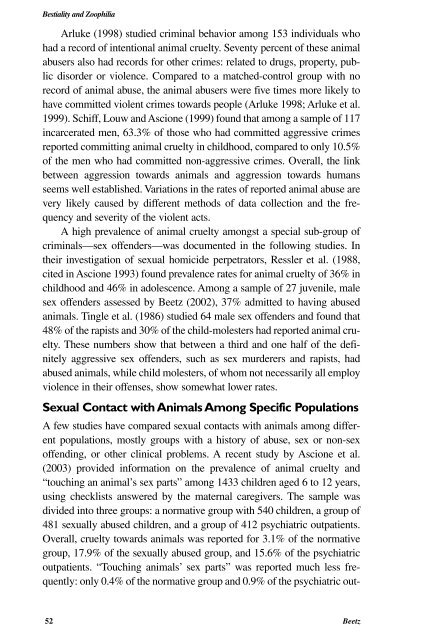Bestiality and zoophilia - Evolve For Animals
Bestiality and zoophilia - Evolve For Animals
Bestiality and zoophilia - Evolve For Animals
Create successful ePaper yourself
Turn your PDF publications into a flip-book with our unique Google optimized e-Paper software.
<strong>Bestiality</strong> <strong>and</strong> ZoophiliaArluke (1998) studied criminal behavior among 153 individuals whohad a record of intentional animal cruelty. Seventy percent of these animalabusers also had records for other crimes: related to drugs, property, publicdisorder or violence. Compared to a matched-control group with norecord of animal abuse, the animal abusers were five times more likely tohave committed violent crimes towards people (Arluke 1998; Arluke et al.1999). Schiff, Louw <strong>and</strong> Ascione (1999) found that among a sample of 117incarcerated men, 63.3% of those who had committed aggressive crimesreported committing animal cruelty in childhood, compared to only 10.5%of the men who had committed non-aggressive crimes. Overall, the linkbetween aggression towards animals <strong>and</strong> aggression towards humansseems well established. Variations in the rates of reported animal abuse arevery likely caused by different methods of data collection <strong>and</strong> the frequency<strong>and</strong> severity of the violent acts.A high prevalence of animal cruelty amongst a special sub-group ofcriminals—sex offenders—was documented in the following studies. Intheir investigation of sexual homicide perpetrators, Ressler et al. (1988,cited in Ascione 1993) found prevalence rates for animal cruelty of 36% inchildhood <strong>and</strong> 46% in adolescence. Among a sample of 27 juvenile, malesex offenders assessed by Beetz (2002), 37% admitted to having abusedanimals. Tingle et al. (1986) studied 64 male sex offenders <strong>and</strong> found that48% of the rapists <strong>and</strong> 30% of the child-molesters had reported animal cruelty.These numbers show that between a third <strong>and</strong> one half of the definitelyaggressive sex offenders, such as sex murderers <strong>and</strong> rapists, hadabused animals, while child molesters, of whom not necessarily all employviolence in their offenses, show somewhat lower rates.Sexual Contact with <strong>Animals</strong> Among Specific PopulationsA few studies have compared sexual contacts with animals among differentpopulations, mostly groups with a history of abuse, sex or non-sexoffending, or other clinical problems. A recent study by Ascione et al.(2003) provided information on the prevalence of animal cruelty <strong>and</strong>“touching an animal’s sex parts” among 1433 children aged 6 to 12 years,using checklists answered by the maternal caregivers. The sample wasdivided into three groups: a normative group with 540 children, a group of481 sexually abused children, <strong>and</strong> a group of 412 psychiatric outpatients.Overall, cruelty towards animals was reported for 3.1% of the normativegroup, 17.9% of the sexually abused group, <strong>and</strong> 15.6% of the psychiatricoutpatients. “Touching animals’ sex parts” was reported much less frequently:only 0.4% of the normative group <strong>and</strong> 0.9% of the psychiatric out-52 Beetz


